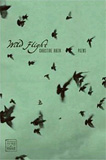Review by Mary Harwell Sayler
WILD FLIGHT
by Christine Rhein
Texas Tech University Press
Box 41037
Lubbock, Texas 79409-1037
ISBN-13 978-0896726215
2009, 103 pp., $l6.95
www.ttup.ttu.edu
This first book of poetry by Christine Rhein drew me to write my first poetry book review, unless you count the quickies I sometimes post on Amazon. Other drawing cards included a general interest in narrative verse and, more particularly, in poetic treatment of WWII, which the poet addresses from the perspective of her father as a child, fleeing from his native Germany during occupation by the Russians then the Poles. Who knew, but somewhere in their own homeland apart from the infamous prison camps, two million German civilians died of starvation, exposure, or torture during the war.
Fortunately, my father, a nose-gunner on a B-24 (aka “Flying Coffin”) escaped those days, and I’m happy to say the poet’s dad did too. Otherwise, “happy” is not a word that propels the reader or the diverse flight patterns in these poetic pages. Indeed, in section III of the V, the poet quotes her father, saying, “Happy is an American idea./ He seeks to be content.” One suspects the poet may be writing toward that end too. Nevertheless, flights of family story, memory, and news flash leap into such contemporary conflicts as Sarajevo where a librarian was killed “by shellburst as she tried to save rare books from flames,” even though surviving the winter took “two books to cook one pot of soup.”
Other victims or defeated ones pile up their poetic bodies—for instance, the old woman on a subway wearing “shoes wrapped with duct tape” and a “homeless man guarding his spot” and the welder who sells a kidney and the man whose “eyes question the camera” in a photograph taken after his family had been killed and his arms chopped off by a machete.
As the flight trajectory continues through these close and far encounters of terror, the theme becomes apparent in “Story Problems” where the poet quotes: “A single death is a tragedy, a million deaths/ a statistic.” Although I’d heard that oft-repeated thought, I did not know the words originated with Stalin. But therein lies the problem, perhaps, for a reader whose family came to America over 400 years ago—presumably long enough for me to be thoroughly indoctrinated in the pursuit of happiness.
Admittedly, I wanted more happy in this book. However, the poetic flights into inhumane conditions of human suffering express an excellent attempt to show the value of life and to elevate suffering into a place of honor. I commend the poet for this endeavor, but ironically, the emotional charge of countless horror stories comes across as that undesired statistic of which Stalin warned. True, he’s not the person from whom I’d most likely take advice. Yet a single poem or two or ten portrays tragedy with dignity, whereas too many weigh the reader down, shutting off the intended emotional impact. I consider this not a problem with the poems or the poet, whose work shows much promise, but with the process of deciding what to include. For this poet, who confesses to not knowing what to put in or leave out of her own waylaid books of poetry, less just might have been more.
In the final section of the book, an airline flight lifts a wing into “the place called making a baby happy.” And the next poem, “Hero,” again has a child rescue the reader by flying a “high bright red helicopter” with the “flight of fireflies, bodies glowing/ from both desire and defense.” Albeit brief, these flights of anticipation continue in “On Art,” which exhibits something akin to kenning in a “hope-yellow sky” or “blink-quick” chickadee who soars off with seeds, awakening a determination “to remember the pinch of tiny claws/ the flutter of something wild.”
The art of collecting and recollecting begins, of course, with event and observation, with life lived on the carpet or the sidewalk or somewhere in the air. In much of Wild Flight, the poems either express a cause for panic or evoke the sense of being pursued, rather than pursuing, but then “Our Twenty-First Summer, Chimney Swifts” calls forth creatures who, “Not built to perch…can’t land/ in the grass or on a branch./ They live mostly in the air/ even mating on the wing.”
Although the chronic flight of the chimney swift offers little hope of settling down into either a happy nest or happiness, the final poem awakens to an acceptance that borders on both: “So why not write about the strawberry finches/ building a nest outside my front window.” Why not write about the nearest thing with its “burden of a long, complicated twig” trying again and again to find a way “into the green” or “the work of weaving” and yes! Why not? This reader, at least, hopes the poet will continue to seek, to soar, to descend but also ascend, to fly and fly and find.
Comments are closed.